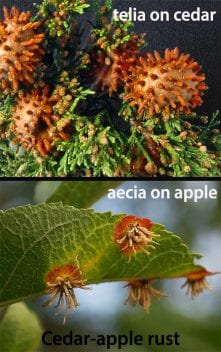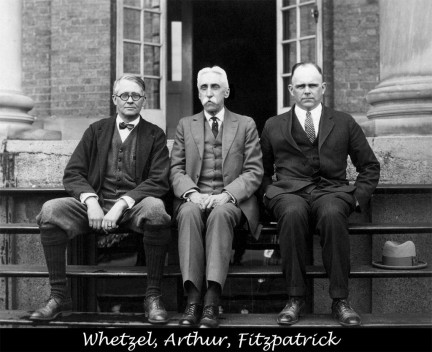Connecting the Rusts
 Here’s a strange sight you might see while plying your canoe round the edges of a pond, or wading through a swamp. See how fresh and orange, how mysterious? This swelling on the stem of Swamp Loosestrife (Decodon verticillatus) is caused by a rust fungus called Puccinia minutissima. It’s covered the swollen stem with tiny fruiting bodies called aecia (say, “EE-see-ya”), and is busy cranking out itty bitty aeciospores.
Here’s a strange sight you might see while plying your canoe round the edges of a pond, or wading through a swamp. See how fresh and orange, how mysterious? This swelling on the stem of Swamp Loosestrife (Decodon verticillatus) is caused by a rust fungus called Puccinia minutissima. It’s covered the swollen stem with tiny fruiting bodies called aecia (say, “EE-see-ya”), and is busy cranking out itty bitty aeciospores.
Rust fungi are very host-specific. You don’t have to worry about them getting hangry and devouring the scenery. Puccinia minutissima attacks Swamp Loosestrife, and turns up its nose at all other plants except ONE. Aeciospores can’t even infect the plant they came from—they must be carried by wind to an entirely different species of plant, their primary host.
J.C. Arthur first described and named this rust back in 1907. But at that time, Dr. Arthur had NO IDEA it could infect Swamp Loosestrife — he’d seen it only on its primary host, the Slender Sedge Carex lasiocarpa, ON WHICH IT LOOKS DRAMATICALLY DIFFERENT. It took years to discover this connection. Today’s topic: How did we ever figure out the rust on Swamp Loosestrife and the rust on Slender Sedge are really the same fungus??
By way of background, I’ll tell you that rust fungi typically have five different stages (see below) and infect two different kinds of plants (they are heteroecious). There are exceptions, of course, but five and two is the strange rule of the rusts. This is what makes us all ask “how did this crazy system evolve?” and why students nervously ask, “is this on the exam?”
 Rusts seem to specialize in baffling all of us. Here’s another seemingly unlikely pair: the fungus that causes Cedar Apple rust makes trouble on apple leaves, and also weird galls on eastern red cedar trees. Same fungus, different plants.
Rusts seem to specialize in baffling all of us. Here’s another seemingly unlikely pair: the fungus that causes Cedar Apple rust makes trouble on apple leaves, and also weird galls on eastern red cedar trees. Same fungus, different plants.
Let us now recite the five kinds of spores:
Spermatia act like pollen—they can fertilize a mate but can’t infect a plant.
Aeciospores can’t infect the plant they were produced on—they must infect a different kind of plant, the primary host.
The spores above are found on the alternate host; those below on the primary host.
Urediniospores are made in huge numbers on the primary host, and spread infection among plants of the same species, sparking epidemics.
Teliospores are made late in the season. They can’t infect a plant, but will wake next Spring to make…
Basidiospores are produced directly from teliospores in the Spring, and can infect only the alternate host.
Anton De Bary was the first to figure out the “two hosts” secret of the rusts, back in the 1860s. Working on Wheat Stem Rust, he found certain spores of wheat rust would NOT infect wheat. Taking a clue from farmers who knew that somehow wheat gets sicker when barberry bushes are near, in 1865 De Bary sowed those recalcitrant spores on barberry and Eureka! He discovered that barberry is the alternate host of the wheat rust fungus. Without both wheat and barberry, the fungus cannot complete its life cycle. Knowing this might help you manage the disease. This discovery is just one of the reasons we call De Bary a founding father of both Mycology and Plant Pathology.
High five, De Bary! That’s how you do it. Now back to J.C. Arthur. He was the first Botanist at the New York State Agriculture Experiment Station (now part of Cornell). His seminal work on fire blight showed that this destructive disease of apples and pears was caused by a bacteria. After earning his Doctor of Science at Cornell in 1886, he headed to Purdue University, where he bravely confronted the rusts.
At Purdue, Arthur discovered and named many rust fungi and studied their biology. Among his greatest contributions was to figure out their life cycles, finding and connecting a rust’s life stages on two plant hosts. This was an incredible enterprise. Rusts couldn’t be grown in petri dishes. To figure out how they spend their lives, one had to harvest aeciospores (Spring), or teliospores (Fall) from one plant and sow them on other suspects. Then wait and see.

Over three years, Canadian mycologist John Dearness sent Fall samples of rusted Slender Sedge from the shores of Lake Huron to Arthur in Indiana. For two Springs, Arthur’s assistants meticulously sowed the spores on all kinds of different plants that share a similar habitat. Nothing. Then a clue from a colleague in Michigan led them to try the spores on Swamp Loosestrife, which quickly and gloriously became infected. Success!
To give you a sense of how much work was involved in this effort to connect rust life cycles: Arthur reported that 2140 packets of spores were dispensed in over 3750 sowings. The plants had to be grown and monitored in greenhouses. The crew relied heavily on natural history observations of Arthur’s many collaborators to decide which plants to test. For two decades Arthur and a whole crew of young assistants labored over the North American rusts, naming them and connecting their life cycles. This, my friends, is how we know which rust life cycles require two kinds of plants, and which plants those are.
Rusts have simple, microscopic structures; they have sophisticated tastes in plants. There are over 7000 rust species. To identify a rust, one often needs to know what plant it’s on, and which of the five possible kinds of spores one is looking at. In this, Arthur’s enduring 1939 ‘Manual of Plant Rusts’ is still a standard text.
Incidentally, The Roman God of Rust, Robigus, was a cruel sort. You might be able to appease him by sacrificing a red dog during Robigalia (April 25—mark your calendars), or he might blight your whole crop with rust. Rusts themselves can be cruel too: Right now, Coffee Rust is devouring coffee farmers’ profits. Myrtle Rust threatens to wipe out key Australian ecosystems. White Pine Blister rust changed the American economy. Wheat rusts have stolen countless human lives.
References
- George B. Cummins 1978. J.C. Arthur: The man and his work. Ann. Rev. Phytopathol. 16:19-30.
- J.C. Arthur. 1915. Cultures of Uredineae in 1912, 1913, and 1914. Mycologia 7: 61-89.
Image by Ryan Wicks of a rust on Decodon verticillatus (swamp loosestrife), used with kind permission.
Image of Cedar Apple Rust on apple leaf by Ronincmc [CC BY-SA 4.0], from Wikimedia Commons.
Cedar Apple Rust galls on Eastern Red Cedar by Kent Loeffler for Cornell.
Image of H.H. Whetzel (L), J.C. Arthur (Center), and H.M. Fitzpatrick (R), taken by H.H. Lyons, March 16 1925 on the steps of Bailey Hall at Cornell University. Cornell Plant Pathology Herbarium image collection.


I love this! Thank you for the details of how rust works using two plants to spread.